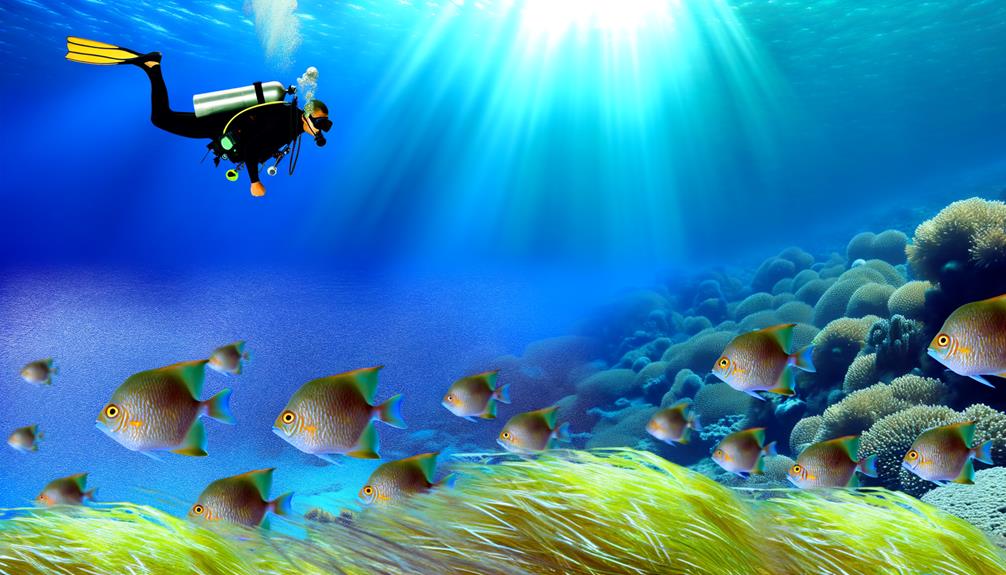This blog contains affiliate links. As part of afiiliate networks and as an Amazon Associate, I earn from qualifying purchases. If you make a purchase through these links, I may earn a small commission at no additional cost to you. I only recommend products and services that I believe in and have personally used or researched. Your support helps me continue to provide quality content—thank you!
You’re looking to venture into the fascinating world of marine biology, and you need the best field guides to help you explore. From the exhaustive National Audubon Society Guide to Marine Mammals to the kid-friendly Ultimate Shark Field Guide, there’s a guide out there for you. Whether you’re a student, researcher, or enthusiast, you’ll find a field guide that suits your needs. Explore regional guides like A Field Guide to the Southeast Coast & Gulf of Mexico or specialized guides like Field Guide to Whales, Dolphins and Porpoises. You’re about to set out on a journey that will take you deeper into the ocean’s secrets – and there’s still so much more to discover.
Key Takeaways
- The National Audubon Society Guide to Marine Mammals is a comprehensive guide for learners, researchers, and enthusiasts, covering various species with in-depth information and excellent illustrations.
- The Field Guide to Marine Mammals of the Pacific Coast provides detailed species accounts, range maps, and descriptions, making it an essential resource for identifying marine mammals.
- The Ultimate Shark Field Guide is a beautifully illustrated and thoroughly researched guide perfect for kids aged 4-5 years old who are fascinated by sharks and ocean exploration.
- The National Audubon Society Field Guide to Seashore Creatures is a thorough guide for exploring marine life, with stunning visuals and clear pictures to identify even the smallest sea creatures.
- Regional field guides like A Field Guide to the Southeast Coast & Gulf of Mexico provide richly illustrated and packed information, making them a must-have for nature and wildlife lovers.
National Audubon Society Guide to Marine Mammals
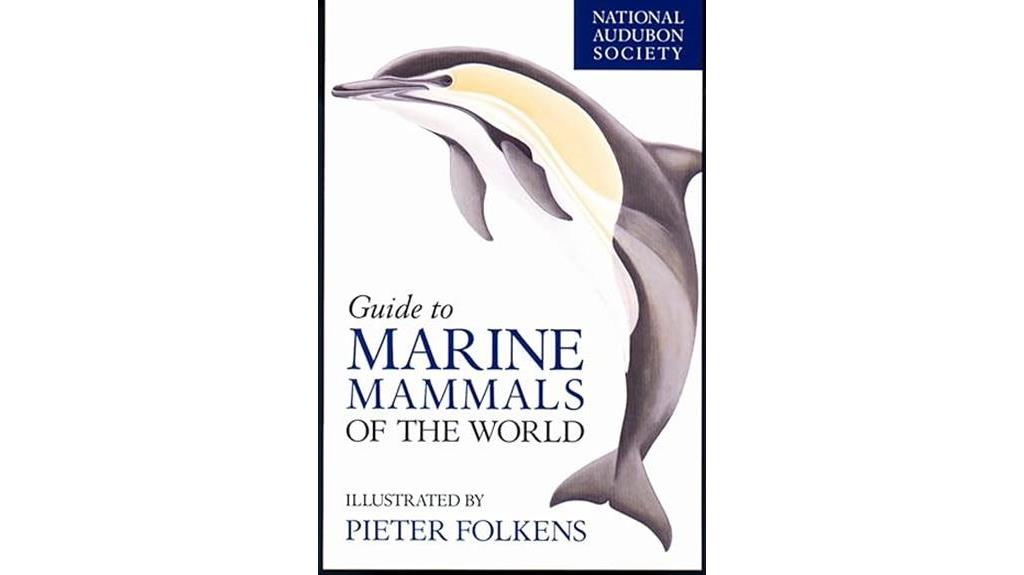
If you’re seeking a thorough and authoritative guide to marine mammals, the National Audubon Society Guide to Marine Mammals is an excellent choice, packed with detailed information and stunning visuals that make it an indispensable resource for learners, researchers, and enthusiasts alike.
You’ll appreciate the exhaustive coverage of marine mammals, featuring 528 pages of in-depth information and excellent illustrations.
The guide’s clear text and high-quality photographs make it perfect for both in-class learning and individual exploration.
Whether you’re a student, researcher, or simply an enthusiast, this guide will become your go-to reference for marine mammals, helping you identify and learn about various species with ease.
Best For: Students, researchers, and enthusiasts of marine mammals seeking a comprehensive and authoritative guide to learn about and identify various species.
Pros:
- Comprehensive coverage of marine mammals with 528 pages of in-depth information and excellent illustrations
- Clear text and high-quality photographs make it perfect for both in-class learning and individual exploration
- Indispensable resource for learners, researchers, and enthusiasts alike, helping to identify and learn about various species with ease
Cons:
- Researchers looking for referenced material may need to supplement with additional resources
- No other notable drawbacks mentioned in reviews
- None mentioned
The Ultimate Shark Field Guide

This field guide is the perfect companion for kids aged 4-5 years old who are fascinated by sharks and ocean exploration.
Each shark is showcased over two pages, complete with detailed illustrations and interesting facts about their behaviors and recognition tips.
The high-quality paper and rich color print make it a joy to flip through, and the sturdy cover protects it from curious little hands.
As you explore the guide with your child, you’ll appreciate the well-written and organized content that’s both fun and educational.
This field guide is a great gift for any young shark enthusiast, and it’s perfect for sparking their curiosity about the ocean and its incredible creatures.
Best For: Kids aged 4-5 years old who are fascinated by sharks and ocean exploration.
Pros:
- Beautifully illustrated and thoroughly researched content
- High-quality paper and rich color print make it a joy to flip through
- Well-written and organized content that’s both fun and educational
Cons:
- Leather cover feels cheap
- Pictures are creased, but this issue resolves once the spine is broken in
- Information about each shark is basic
National Audubon Society Field Guide to Seashore Creatures
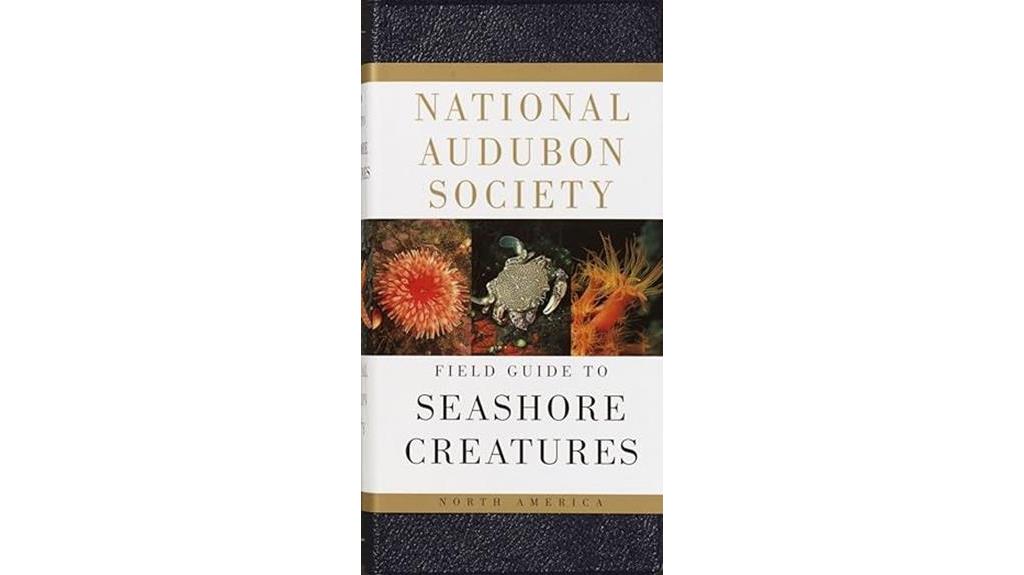
The National Audubon Society Field Guide to Seashore Creatures is the perfect companion for anyone enthusiastic to explore the fascinating world of marine life, thanks to its thorough coverage and stunning visuals.
With its clear pictures and short write-ups about each animal, you’ll be able to identify even the smallest sea creatures.
The photography is gorgeous, making it perfect for learning about sea life.
You’ll appreciate the durable plastic leather binding that keeps the book from getting folded or wrinkled.
Whether you’re exploring the beaches on the west coast or identifying marine life in Southern seas, this guide is a valuable resource.
With its exhaustive coverage, you’ll be able to learn about every little sea urchin, starfish, or barnacle you encounter.
Best For: Those enthusiastic about exploring the fascinating world of marine life, including families with children and individuals who enjoy learning about sea creatures.
Pros:
- The book is comprehensive, with clear pictures and short write-ups about each animal, making it easy to identify even the smallest sea creatures.
- The photography is gorgeous, perfect for learning about sea life, and the durable plastic leather binding keeps the book from getting folded or wrinkled.
- The book is useful for identifying marine life, whether exploring the beaches on the west coast or identifying marine life in Southern seas.
Cons:
- The pictures should be placed with the individual species, not in a separate section, to improve the layout.
- The layout could be improved with more differentiation between sections and habitat types.
- The small dust jacket is flimsy, but the book doesn’t look good without it.
A Field Guide to the Southeast Coast & Gulf of Mexico
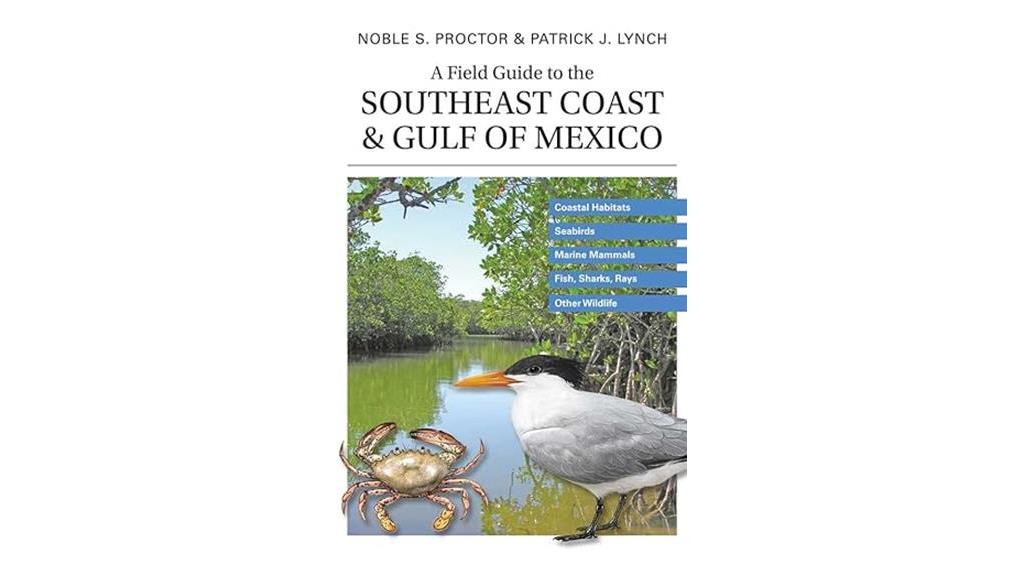
This field guide is the best choice for anyone seeking a thorough and engaging resource to explore the diverse marine life and ecosystems of the Southeast Coast and Gulf of Mexico.
You’ll love how richly illustrated and packed with information it is, making it a must-have for nature and wildlife lovers.
The guide covers a wide range of species, including coastal habitats, seabirds, marine mammals, fish, and even shore-visiting sharks.
You’ll appreciate how well-organized it is, making it easy to navigate and find the information you need.
Whether you’re a beginner, a student, or just someone who loves the coast, this guide is suitable for you, providing an excellent introduction to the local ecosystems and helping you identify species with ease.
Best For: Those who live on the coast, visit the coast, or have a love for the coast and its life, including beginners, kids, adults, and high school biology or aquatic science students.
Pros:
- Richly illustrated and packed with information, making it a great resource for nature and wildlife lovers
- Well-organized and easy to navigate, with clear and concise descriptions
- Covers a wide range of species, including coastal habitats, seabirds, marine mammals, fish, and even shore-visiting sharks
Cons:
- Omits river otters from the list of animals common to Florida
- Focuses heavily on vertebrates, making it less balanced than other guides
- May not be suitable for those seeking a more scientific or graduate-level book
Field Guide to Whales, Dolphins and Porpoises (Bloomsbury Naturalist)
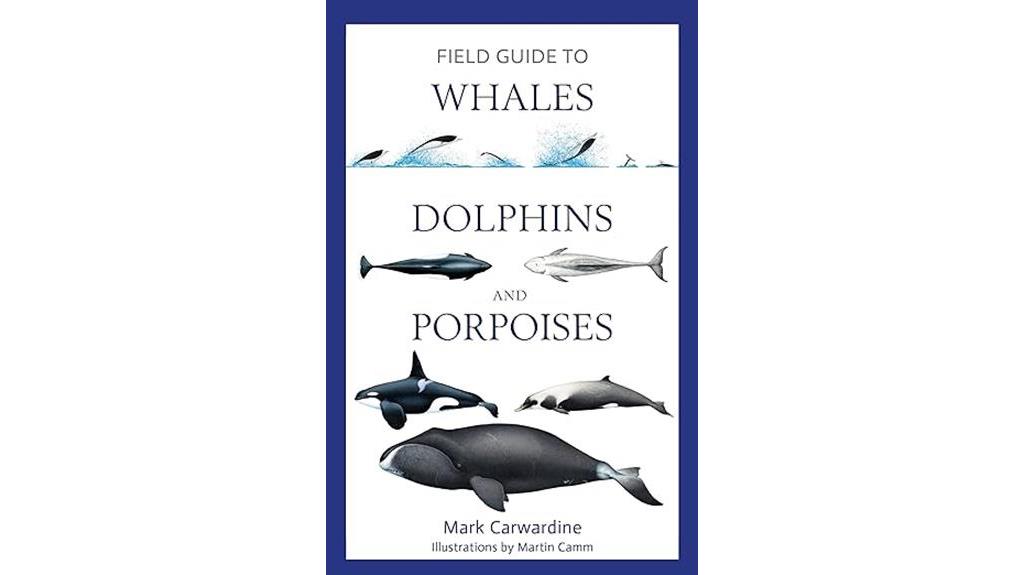
If you’re a marine enthusiast or researcher seeking a thorough and up-to-date guide to identifying cetaceans, the Field Guide to Whales, Dolphins and Porpoises (Bloomsbury Naturalist) is an indispensable resource that will help you navigate the complex world of whales, dolphins, and porpoises.
This exhaustive guide provides detailed descriptions and stunning illustrations of these majestic creatures, making it an absolute must-have for anyone serious about marine biology.
You’ll appreciate the book’s in-depth information on species like the newly recognized Rices whale (Balaenoptera ricei) and the dark-colored Berardius species, now known as Berardius minimus.
With its meticulous research and striking visuals, this field guide is sure to open up a new world of marine discovery for you.
Best For: Marine enthusiasts, researchers, and anyone serious about marine biology who want a thorough and up-to-date guide to identifying cetaceans.
Pros:
- Absolutely great resource full of information and illustrations
- Recognizes newly identified species like the Rices whale (Balaenoptera ricei) and the dark-colored Berardius species (Berardius minimus)
- Provides detailed descriptions and stunning illustrations of whales, dolphins, and porpoises
Cons:
- Some customers have reported receiving poorly packaged books with defects
- Omits comments about the etymology for the common and scientific names of each cetacean species
- No other criticisms or issues reported
National Audubon Society Field Guide to Tropical Marine Fishes
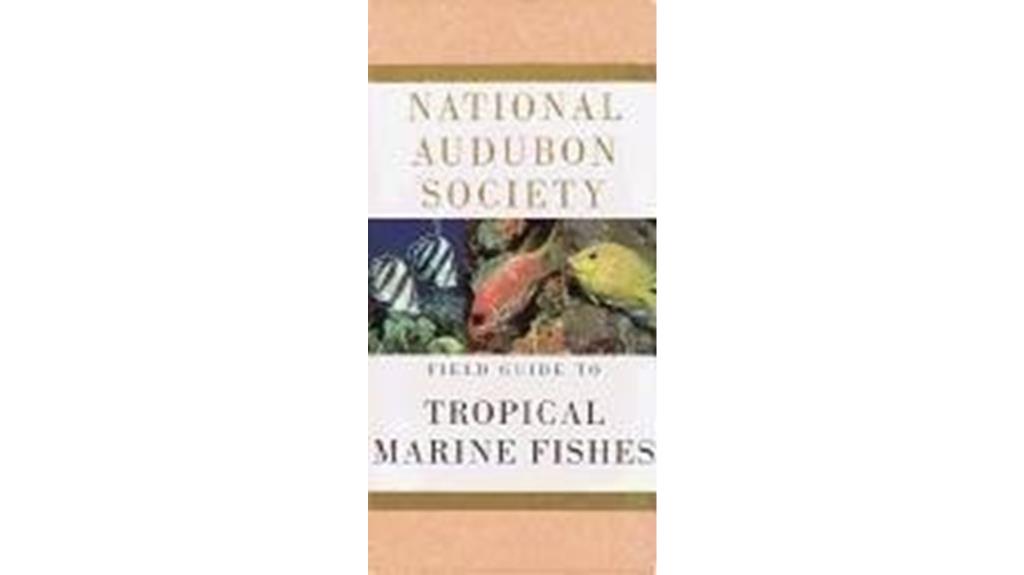
Scuba divers and snorkelers traveling to the Caribbean will find the National Audubon Society Field Guide to Tropical Marine Fishes an indispensable companion for identifying the vibrant fish species they encounter.
You’ll appreciate the high-quality pictures and descriptions that make it easy to spot the fish you see underwater.
The beautiful photos and updated information will help you learn more about the marine life you’re observing.
You’ll also appreciate the reasonable price and fast shipping.
Whether you’re a diver, snorkeler, or just someone who loves the ocean, this guide is a must-have.
You’ll refer to it often, and it makes a great gift for fellow ocean enthusiasts.
Best For: Scuba divers, snorkelers, and ocean enthusiasts who want to identify and learn about tropical marine fish species.
Pros:
- High-quality pictures and descriptions make it easy to identify fish species
- Reasonable price and fast shipping make it a great value
- Beautiful photos and updated information make it a must-have for ocean enthusiasts
Cons:
- Some photos may not be the best quality, which can make identification difficult
- Drawings may have been a better option for some species
- The guide could be improved by including more information on how to distinguish between similar-looking species
Field Guide to Marine Mammals of the Pacific Coast
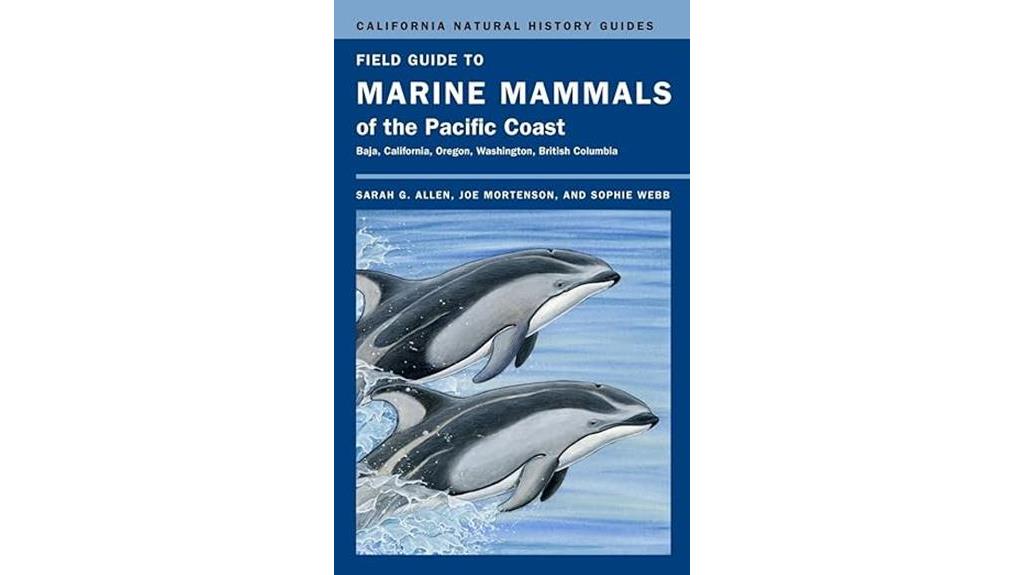
When planning a whale-watching trip off California’s coast, you’ll want to bring along the ‘Field Guide to Marine Mammals of the Pacific Coast‘ as your trusted companion.
This thorough guide covers marine mammals of the Pacific Coast, including whales, dolphins, porpoises, and seals.
You’ll find detailed species accounts with range maps, descriptions, and field marks, along with 19 beautifully painted plates of the mammals.
The guide also offers further information on natural history, including life histories and interesting facts.
Photographs are included to aid in identification, making it a valuable resource for interpreters and volunteers on whale watch boats.
With its thoroughness and usefulness, this guide is a great value for the money, and you’ll appreciate having it by your side as you spot these magnificent creatures in their natural habitat.
Best For: Whale watchers, interpreters, and volunteers on whale watch boats off the California coast who want a thorough and informative guide to marine mammals.
Pros:
- Provides detailed species accounts with range maps, descriptions, and field marks
- Includes 19 beautifully painted plates of the mammals and photographs to aid in identification
- Offers further information on natural history, including life histories and interesting facts
Cons:
- Focused only on the west coast, with limited general knowledge about marine mammals
- Lacks full-body photos of the whales, making it difficult to visualize their appearance
- Weighs too much for its size, making it less portable
National Audubon Society Field Guide to Fishes
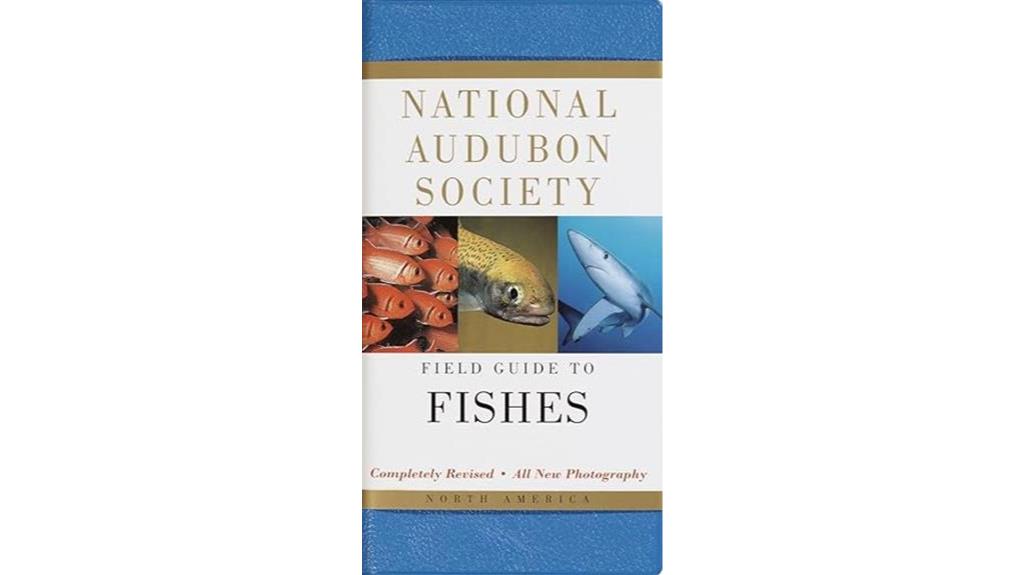
The National Audubon Society Field Guide to Fishes is a beautifully designed book that’s perfect for fishermen, student oceanographers, and divers seeking to identify fish species with its detailed information and vibrant photos.
You’ll find it helpful for identifying fish species, and it’s a great reference for ichthyology classes or lab courses.
The book’s well-designed layout and good organization make it easy to find the information you need.
The photos are beautiful, and the vinyl cover is easy to clean.
Some users suggest including alternate local names for fish species and splitting the guide into regional volumes for more in-depth coverage.
Overall, you’ll enjoy using this guide, whether you’re a student, researcher, or simply someone who loves reading about sea animals.
Best For: Fishermen, student oceanographers, divers, students in ichthyology classes, and anyone interested in learning about fish species.
Pros:
- Beautifully designed book with detailed information on fish species and vibrant photos
- Helpful for identifying fish species and great reference for ichthyology classes or lab courses
- Well-designed layout and good organization make it easy to find the information you need
Cons:
- Some users were disappointed with updated photographs, particularly the Atlantic Wolf Fish
- Some pictures could be improved, and dead museum pictures should be replaced with catch-and-release photos
- Some species lack photos or line drawings
Macs Field Guides: North American Marine Mammals (Macs Guides (Paperback))
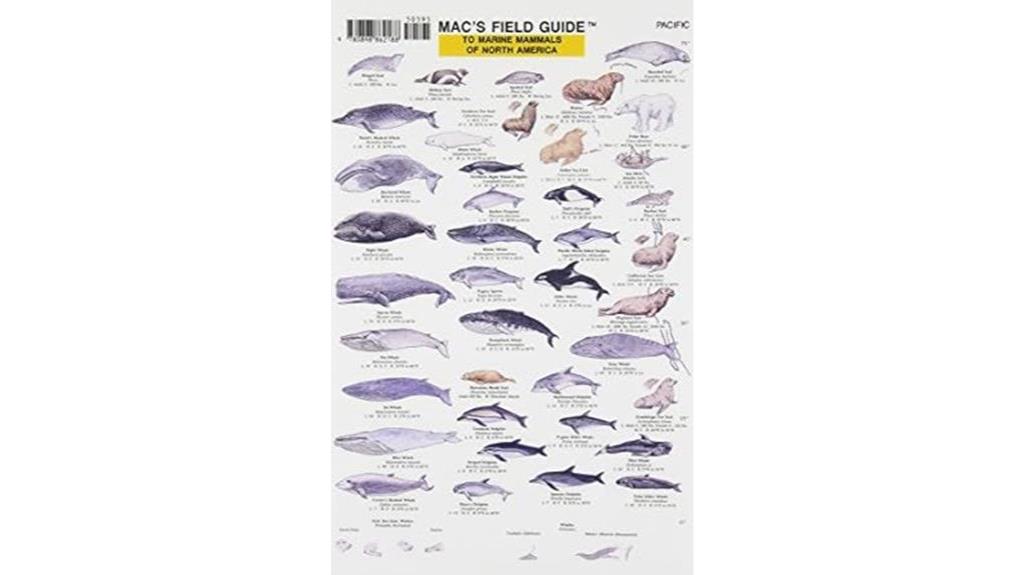
If you’re looking for a thorough guide to help you identify marine mammals on your next ferry ride or coastal adventure, Macs Field Guides: North American Marine Mammals is an excellent choice.
You can take it with you on your ferry ride or coastal trip, and its laminated pages will withstand any wet weather conditions.
The guide is packed with detailed information and beautifully illustrated pictures of each marine mammal, making it easy for you to identify the creatures you see.
The pictures are large enough for kids to decipher, and the guide is handy to keep on hand while viewing wildlife.
Whether you’re a parent looking for a fun educational tool or a Boy Scout working on your Nature or Oceanography merit badge, this guide is a great resource to have.
Best For: Families with children, Boy Scouts, and nature enthusiasts who want to identify marine mammals during ferry rides or coastal adventures.
Pros:
- Laminated pages make the guide durable and suitable for wet weather conditions
- Detailed information and beautifully illustrated pictures help with easy identification of marine mammals
- Handy size and design make it easy to carry and use while viewing wildlife
Cons:
- None mentioned
A Field Guide to Coastal Fishes: From Alaska to California
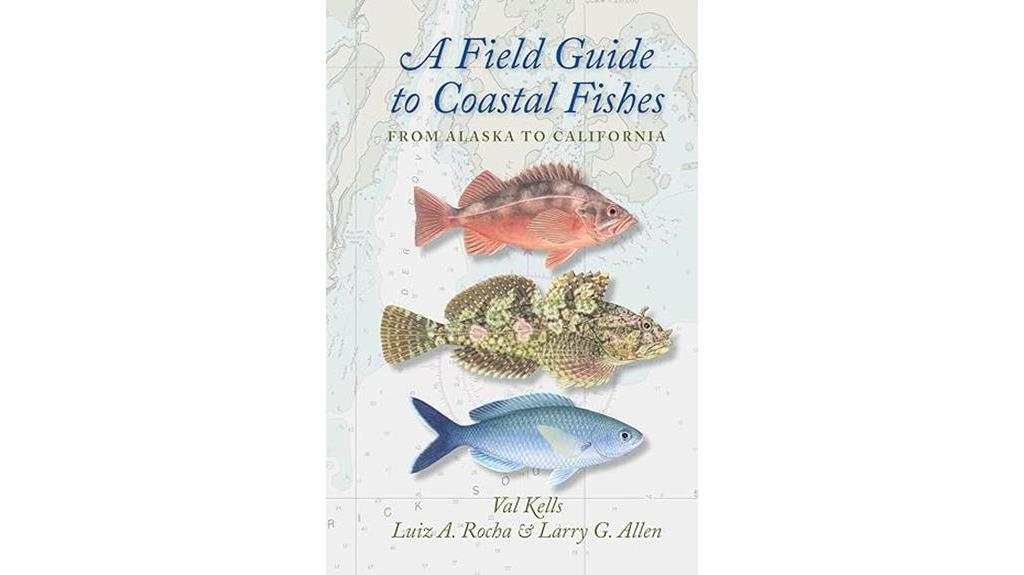
Living on the west coast, you’ll find A Field Guide to Coastal Fishes: From Alaska to California to be an indispensable resource, tailor-made for anyone seeking to identify Pacific coastal fishes with ease.
This excellent guidebook is packed with gorgeous, exceptionally detailed illustrations that are worth the price of the book alone.
Each fish is accompanied by basic information, making it easy to identify species.
The artwork is so good that it’s even a great reference for fish artists.
You’ll appreciate how the illustrations help you identify structures, and the descriptions are adequate for identification.
As a go-to resource, you’ll find yourself reaching for this guide time and time again to identify the various species of fishes you encounter on the California coast.
Best For: Anyone interested in identifying Pacific coastal fishes, particularly those who live on the west coast.
Pros:
- Excellent guide book with great illustrations and basic information
- Highly recommended for anyone interested in identifying Pacific coastal fishes
- Outstanding artwork that is worth the price of the book alone
Cons:
- None mentioned in the review
Factors to Consider When Choosing Marine Biology Fluid Guides
When it comes to choosing a marine biology fluid guide, you’ll want to deliberate a few key factors to guarantee you get the right one for your needs.
You’ll need to ponder your specific field of interest, the type of marine life you’re studying, and the region you’re working in.
Field of Interest
Your specific area of study within marine biology greatly influences the type of fluid guide you’ll need, as different fields require varying levels of precision and detail.
If you’re studying coral reefs, you’ll need a guide that provides detailed information on the complex relationships between coral species and their environments. On the other hand, if you’re focused on marine conservation, you might prioritize a guide that covers policy and management practices.
Consider the scope of your research or project: are you examining a specific ecosystem, like estuaries or deep-sea vents?
Or are you exploring broader topics, such as ocean currents or marine pollution?
Your field of interest will dictate the level of specificity and breadth of information you need from your fluid guide.
Specific Marine Life
You’ll likely need to explore guides that focus on specific marine life, such as marine mammals, fish, or sharks, depending on your research goals.
If you’re interested in marine mammals, guides like the National Audubon Society Field Guide to Marine Mammals or Macs Field Guides: North American Marine Mammals can provide valuable information. These guides cover a wide range of species, including whales, dolphins, porpoises, and seals, with detailed descriptions and range maps.
If fish are your focus, The Field Guide to Coastal Fishes: From Alaska to California is an excellent resource, featuring exceptionally detailed illustrations of various fish species.
For those interested in tropical marine fish, The National Audubon Society Field Guide to Tropical Marine Fishes is an exhaustive guide that covers fish species found in the Caribbean and Atlantic Ocean, with beautiful pictures and updated information.
If sharks are your passion, The Ultimate Shark Field Guide is a high-quality guide with detailed illustrations and fun facts about shark species, making it perfect for kids and adults alike.
Regional Focus Needed
As you explore the vast world of marine biology, a regional focus becomes essential in your guide selection, since species diversity and distribution vary greatly across different coastal regions and ecosystems.
You’ll find that guides that cover a specific region, such as the Pacific Coast or the Gulf of Mexico, provide more in-depth information on the unique species and habitats found in those areas.
This regional focus allows for more accurate and detailed information on species identification, habitat, and behavior, which is vital for researchers, students, and enthusiasts.
Furthermore, guides that focus on a specific region often include information on local conservation efforts, habitat preservation, and species management, which is essential for informed decision-making and sustainable practices.
By focusing on a specific region, you’ll gain a deeper understanding of the complex interactions between species, habitats, and environmental factors that shape marine ecosystems.
This nuanced approach will help you make more informed decisions and contribute to the conservation of our precious marine resources.
Level of Expertise Required
When selecting a marine biology fluid guide, consider your level of expertise, as it substantially impacts the guide’s effectiveness, with different guides catering to various levels of knowledge, from beginner-friendly resources to specialized texts for advanced researchers.
As a beginner, you’ll want a guide that’s easy to understand, with clear illustrations and introductory information. These guides are perfect for amateur naturalists or those new to marine biology.
If you’re an intermediate or advanced learner, you may prefer guides that assume some background knowledge, using technical terms and providing in-depth information on specific species or ecosystems.
As you progress in your marine biology journey, you may require highly specialized guides that explore nuanced topics, such as species’ habitats, behaviors, or conservation status. Remember, your prior experience with marine biology and ability to identify and classify species also play a significant role in determining the level of expertise required to effectively use a field guide.
Portability and Durability
Your marine biology fluid guide needs to withstand the harsh conditions of the marine environment, so you must prioritize portability and durability when making your selection.
You’ll be using your guide in the field or on a boat, where space is limited and conditions are rough. A compact size and lightweight design are essential for easy carrying and convenience.
Look for a guide with a waterproof or water-resistant cover to protect it from exposure to saltwater and sunlight. The binding and cover materials should be able to withstand rough handling and harsh marine conditions.
Consider a guide with laminated pages or a waterproof coating to protect against accidental splashes or immersion. A sturdy binding is also vital, as it will be opened and closed frequently.

Erzsebet Frey (Eli Frey) is an ecologist and online entrepreneur with a Master of Science in Ecology from the University of Belgrade. Originally from Serbia, she has lived in Sri Lanka since 2017. Eli has worked internationally in countries like Oman, Brazil, Germany, and Sri Lanka. In 2018, she expanded into SEO and blogging, completing courses from UC Davis and Edinburgh. Eli has founded multiple websites focused on biology, ecology, environmental science, sustainable and simple living, and outdoor activities. She enjoys creating nature and simple living videos on YouTube and participates in speleology, diving, and hiking.
🌿 Explore the Wild Side!
Discover eBooks, guides, templates and stylish wildlife-themed T-shirts, notebooks, scrunchies, bandanas, and tote bags. Perfect for nature lovers and wildlife enthusiasts!
Visit My Shop →
